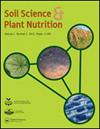Comparative verification of Mehlich 3 soil analysis methods in Northern Mozambique using microwave plasma–atomic emission spectrometry
IF 1.8
4区 农林科学
Q3 ENVIRONMENTAL SCIENCES
引用次数: 0
Abstract
ABSTRACT Regular testing of nutrients in soil samples is important for understanding soil fertility. This study investigated a combination of the Mehlich 3 extraction method and Microwave Plasma-Atomic Emission Spectrometry (MP – AES) for testing the nutrient status in soil to establish a labor-saving and cost-effective analytical method in Northern Mozambique. Available P, exchangeable cations, and micronutrients in the Mehlich 3 extract were measured using conventional methods and compared with those quantified using MP – AES to determine its accuracy. Linear regression analysis implied a high correlation between the Available P extracted via Mehlich 3 and quantified using MP – AES and that extracted via Mehlich 3, Bray 1, Olsen, and Mehlich 1 and quantified using UV – Vis. Moreover, a high determination coefficient (R2 = 0.920) was observed between Mehlich 3 quantified using MP – AES and that quantified using UV – Vis spectroscopy with a low root mean square error (RMSE = 9.245), MP – AES may have accuracy comparable to conventional methods. Linear regression of the exchangeable cations extracted using the Mehlich 3 method and quantified using MP – AES and those extracted using the 1 M NH4OAc method and quantified using ICP – AES revealed that the coefficients of determination of Ca, Mg, and K were 0.952, 0.878, and 0.826, respectively. The coefficient of determination for Na was small at 0.101. For the micronutrients, Mehlich 3 extraction with MP – AES quantification method showed a correlation with the conventional DTPA method; specifically, a strong correlation was observed for Cu and Zn. Although the correlation for Fe and Mn was also high, it was less accurate than that for the other elements. The method used in this study is considered effective for estimating field variability. To convert to conventional methods, variation in available elemental content between sites with different local soil properties should be considered.微波等离子体原子发射光谱法对莫桑比克北部Mehlich 3土壤分析方法的比较验证
本文章由计算机程序翻译,如有差异,请以英文原文为准。
求助全文
约1分钟内获得全文
求助全文
来源期刊

Soil Science and Plant Nutrition
农林科学-农艺学
CiteScore
4.80
自引率
15.00%
发文量
56
审稿时长
18-36 weeks
期刊介绍:
Soil Science and Plant Nutrition is the official English journal of the Japanese Society of Soil Science and Plant Nutrition (JSSSPN), and publishes original research and reviews in soil physics, chemistry and mineralogy; soil biology; plant nutrition; soil genesis, classification and survey; soil fertility; fertilizers and soil amendments; environment; socio cultural soil science. The Journal publishes full length papers, short papers, and reviews.
 求助内容:
求助内容: 应助结果提醒方式:
应助结果提醒方式:


